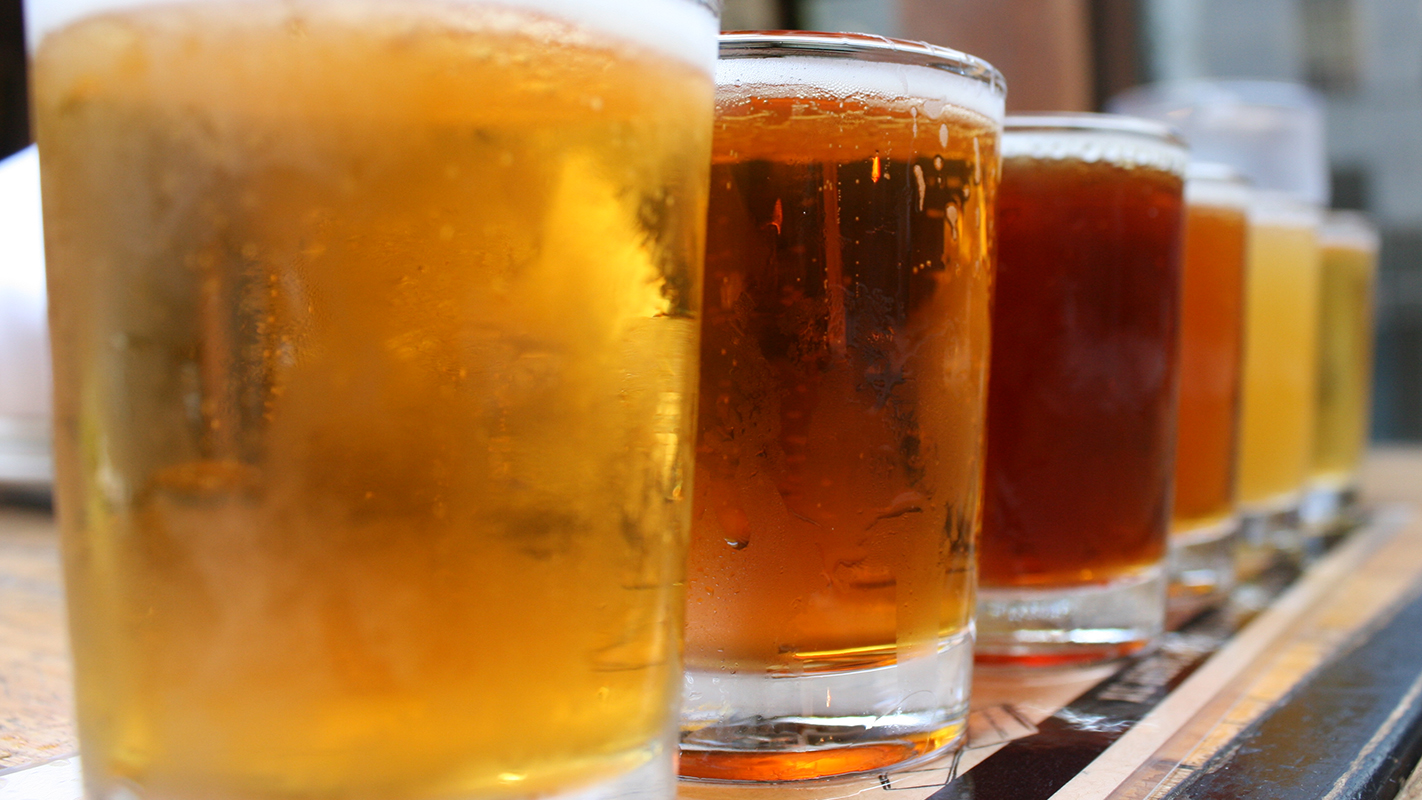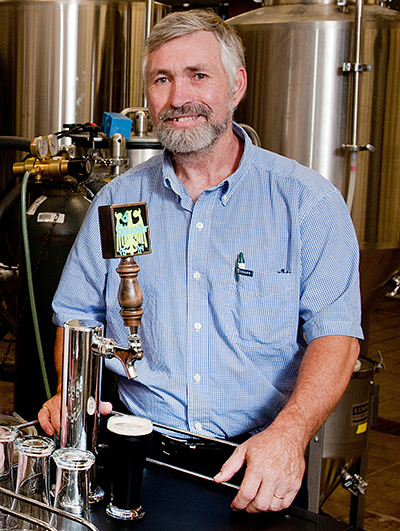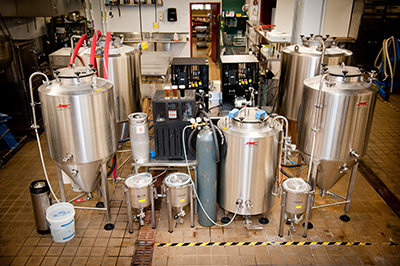Questions About the Science of Beer

Of all the people who really like beer (and there are a lot of them), most don’t really understand how it’s made. Sure, there’s an art to brewing – but there’s science as well. To learn more about the science of beer, we picked the brain of John Sheppard, a professor of bioprocessing science at NC State who does research on beer. (You may have read about his work on using wild yeasts to brew new kinds of beer.)
Read on, and amaze your friends with beer science the next time you’re having a pint.
The Abstract: How do we define beer?

John Sheppard: Beer is defined as an alcoholic beverage based on the fermentation by yeast of malted barley and hops. Only certain countries, like Germany, do not allow for substitution of the barley by other sugar sources, such as rice, wheat or corn.
TA: What do you mean by “malted” barley?
Sheppard: Malting is a process where barley is treated to germinate the seeds – they actually sprout roots. This activates amylase enzymes in the seeds, which break down stored starch into sugars the seed would use to grow. But the germination is stopped by drying the seeds in a kiln. The roots fall off, but the enzymes remain intact and are reactivated during the mashing process.
TA: Okay, what is the mashing process?
Sheppard: The seeds are ground into a flour and are put into a container called a mash tun, along with water that’s hot enough to activate the enzymes but not hot enough to destroy the enzymes.
There are variations to the mashing process, but they all have two things in common. First, the process gives enzymes the time and conditions they need to convert the remaining starch into sugars – mostly maltose, but there are some other sugars as well, such as glucose. In large, commercial brewing, they often add additional enzymes to ensure that all of the starch is converted. Second, the mashing process breaks down the proteins from the seeds into amino acids that yeasts need to grow and reproduce. The liquid result of mashing is called wort, and that is what gets fermented.
TA: How does fermentation work?
Sheppard: In the absence of oxygen, the yeast cells used in brewing convert sugars (such as maltose) into ethanol and carbon dioxide by the process of fermentation. Byproducts of the yeast metabolism – such as chemicals called esters – help in determining the flavor of the final product. [Editor’s note: yeasts are a type of fungus – single-celled organisms that, individually, are invisible to the naked eye.]
TA: What’s the difference between an ale and a lager, and why do different types of yeast need different temperatures to do their thing?
Sheppard: Ale yeast, Saccharomyces cerevisiae, is a so-called “top fermenting” yeast that makes beer relatively quickly at room temperatures – up to 25 degrees Celsius (77 degrees Fahrenheit). The lager yeast, Saccharomyces pastorianus, is a “bottom fermenting” yeast that prefers lower temperatures – 7 to 15 °C (45 to 59 °F) – thereby reducing the rate of fermentation. The stronger-flavored ales are more tolerant of off-flavors that can be produced by the more rapid fermentation, while lagers are more delicate tasting and require the slow fermentation and long maturation periods.
TA: Where does flavor come from – malt, hops, et cetera?

Sheppard: The characteristic flavor of beer is a result of three main components.
First, the unfermented sugars can provide sweetness. Second, hops can provide their own inherent flavors and aromas via aromatic compounds – producing grassy or fruity notes. This is primarily done by “dry hopping,” in which hops are added to the beer after fermentation. But hops can also be added to the wort and boiled before fermentation. This dissolves acids from the hops and isomerizes them, or breaks them down. These acids create the bitter flavors we associate with beer. Third, yeast metabolism provides trace flavor components such as various ketones, esters and alcohols other than ethanol.
In addition, the malting process can also produce sugar compounds called dextrins, which are not normally broken down during fermentation. These dextrins produce the sweet, malty flavors in some beers.
TA: What about the coffee or chocolate flavors we associate with porters and stouts?
Sheppard: Those flavors are produced when brewers use high temperatures in the kiln during the malting process – what some people call the “roasting” of the malt.
TA: While we’re on the subject of flavor, how does exposure to light lead to “skunky” beer?
Sheppard: When beer is exposed to light, it causes photo-oxidation. The energy of the light facilitates a chemical reaction involving sulfur compounds, producing volatile sulfur compounds referred to as mercaptans. One of these compounds, butyl mercaptan, is responsible for the skunky odor.
TA: Where does the carbonation in beer come from?
Sheppard: Carbon dioxide gas is a product of fermentation – the yeast produces it – and the gas becomes dissolved in the beer as the fermentation progresses. This natural carbonation is usually supplemented by adding extra carbon dioxide under pressure during the bottling or kegging process.
TA: Some beers make a big deal about where they get their water from. What affect does the water have on the beer?
Sheppard: The most important aspect of water quality is the level of dissolved minerals, specifically the bicarbonate ion, which determines a water’s “hardness.” The type and amount of minerals in the water can affect the enzymatic conversion of malt into maltose, the metabolism of the yeast, and how the sugars and hop acids influence the flavor of the final beer. For example, English ales are based on water with very high mineral content, while Central European lagers use very soft water for brewing.
TA: I’ve heard of “clarifying hops,” but don’t really know what that means. What is it, and how does it work?
Sheppard: Sometimes as hop residues settle out in the beer, they can help the clarification process by attaching to suspended yeasts and other materials and then sinking to the bottom of the fermenter or tank. This generally only applies if a brewer uses whole hops, rather than ground hops.
TA: What is the upper threshold of alcohol toxicity for different strains of yeast? For example, the upper percentage of alcohol by volume (ABV) for different beer types?
Sheppard: Ethanol begins to become inhibitory or toxic to most yeast at levels as low 3-6 percent ABV. However, brewing strains of yeast that are specially selected for ethanol tolerance are used for both high gravity brewing (7-10 percent ABV) and specialty beers that rival wine (12 percent ABV).
TA: What’s the difference between using malt extract vs. whole grain barley (or other grains)? Why would one use one over the other?
Sheppard: Whole grain barley needs to be malted prior to use in brewing. As we talked about earlier, the malting process activates the enzymes in the barley seeds for subsequent conversion of the starch to sugars. Malt extract is simply a concentrated sugar solution resulting from the mashing, or cooking, of the barley malt, followed by evaporation to remove some of the water.
Performing your own mashing process instead of using malt extract is preferable because it gives you more control over the choice of barley malt to use and the mashing process itself, which affects the characteristics of the final beer.
TA: I know that brewers often use bacteria to create sour beers. How does that work?
Sheppard: The specific character of some sour beers is a result, in part, of using mixed cultures during the fermentation. In addition to conventional brewer’s yeasts, brewers sometimes use a yeast called Brettanomyces or various species of Lactobacillus bacteria to provide unique flavor components – including the acidity that gives the beer its sour flavor.
TA: Last question, and not – strictly speaking – about beer. I know that some other fermented beverages – including chicha and mead – are traditionally made using saliva. What’s that all about?
Sheppard: Saliva naturally contains amylase enzymes which can break down starchy material into fermentable sugar. The saliva effectively takes the place of the mashing and malting process.
- Categories:


